#farmer!Lomi
Explore tagged Tumblr posts
Text

Inktober 2023 - Day 2
#Inktober 2023#painting#watercolour#my art#mimimarilynart#traditional art#I'm actually quite proud of this one even though it's a tiny piece it definitely came out better than I expected :')#farmer au#lady and her cute hubby#Ec#Lomi#Ec x Lomi#Lomi x Ec#lovers#sweethearts#lady!Ec#farmer!Lomi#rly wanna draw something but first I need to get caught up on work ugh ><
21 notes
·
View notes
Text
Everytime i hear news about POGOs feeling ko nag kaka justice na yung trauma na inabot ko nung 2019 Alam kong madami yung mawawalan ng trabaho but Filipinos deserve better.
- Most of the Chinese na nagwowork sa POGO are not using their real name pag pasok ng Pinas. Kaya takot na takot sila lumabas even sa mall kase baka ma question yung pagkatao nila. Kaya di na ko nagtaka kung pano nakalusot si Mayor Alice Guo. Some of them are using an English name.
- Uso kidnapping sa kanila and kapwa Chinese pa nila yung gumagawa nun kase wala naman silang bank account and puro lang sila cash pag sumasahod. 150k+ sahod nila kase once a month lang rd nila. Pero sahod na yun ng limang pinoy sa POGO.
- I won’t forget how disrespectful yung mga Chinese na kawork namin na lalaki. Most of them mas gustong babae yung partner ng Chinese on shift kase nakakapikon talaga yung ugali nila and prone sila sa away. Naranasan kong may nagsusuntukan sa harap ko while on shift. Very unprofessional. Mga bastos pa, they are sexualizing girls na kawork nila including us.
- Mostly na kinukuha nila is mga Chinese nationals na farmers, mga di nakapag aral, and laki sa hirap. Nothing wrong with being a farmer pero i would say na yung iba talaga sa kanila, wala talagang modo and halatang walang pinag aralan.
- Mapanakit sila. Nung naka gy shift ako that time may isang Chinese na trip talaga ko saktan. Habang naka break ako sa labas ng office dinaganan niya yung hita ko ng walang rason and sobrang nagpasa siya. Pinalagpas ko yun kase paborito yun ng boss. Take note na lalaki siya. There are times na bigla nya iuurong yung lamesa na kahoy minsan pag trip nya and babatuhin niya ko ng crumpled paper for no reason. He also used spoon sa balikat ko to call my attention habang kumakain ako ng lomi.
- Tatanggalin ka nila kapag may mistakes ka sa transaction. Puro pera from gambling yung need naming isend from diff banks and may isang Chinese dun na ang lala ng galit sakin. He mentioned thru google translate na malas daw ako. Shuta never ako nagka mistake sa transactions ko kase sobra akong nag iingat. Kalahating araw niya kong pinagmumura in Chinese dahil lang ako partner nya that day and hindi gumana yung pc nya.
- 12 hrs shift mo with 30 mins lunch. Literal na para kang OFW vibe pag andun ka. Yung feeling na alipin ka sa sarili mong bansa. Yung boss namin na Chinese nagagalit ng walang dahilan. Very unreasonable. Nahuli nya kong nagsasalamin and shuta sinigawan nya ko. Yung nag mentor naman sakin na babae, napuno na kase kumuha lang siya ng tissue sa box ang dami ng sinabi nung Chinese. Haha Pinakyuhan ni ate geraldine yung boss namin sabay Resign kinabukasan.
- Kung pera lang ang usapan I would say na eto yung pinaka madaling work na ginawa ko. Kase encoder kalang and same excel sheet lang gagamitin mo everyday. Pero wala siyang growth kase most of the time naka tunganga ka lang.
- I hate my experience in POGO given that 2 mos lang naman tinagal ko dahil gusto ko magpahinga sa BPO, mas ok na kong sigawan ng mga kano sa calls kesa maging alipin ng mga Chinese. Working environment there was awful for me. And inhumane. It was an eyeopener for me na wag magpa api sa sariling mong bansa.
- Some had good experiences with POGO, given that pumapantay at humihigit pa nga sa sahod ng mga bpo workers, pero sana hindi nila ma experience yung mga naexperience ko.
- There are still good Chinese na nakilala ako. Some of them kumapit na lang siguro sa ganitong trabaho to help their families in China. Sila lang yung mga pinagpepray ko na sana ok pa rin up until now.
PERO SATIN PA RIN ANG WEST PHILIPPINES SEA.
11 notes
·
View notes
Photo

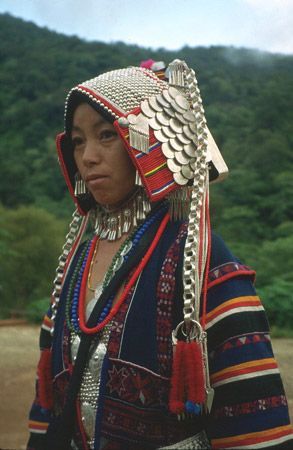
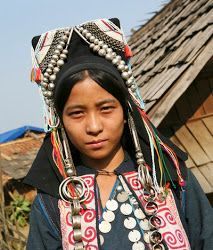

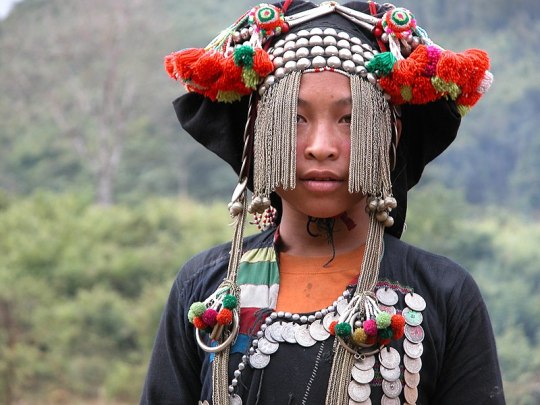

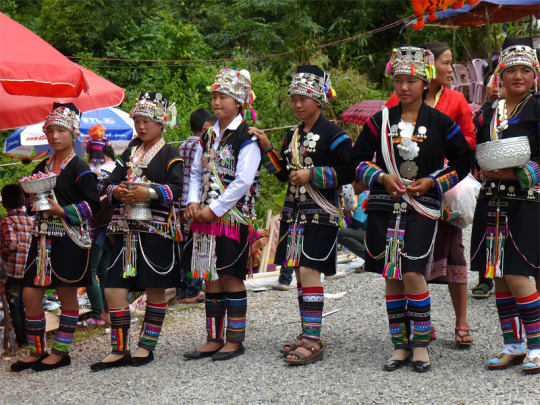
1. Akha hilltribe girl, Chiang Mai flower festival, Thailand by Steve Vidler 2. Pamee Akha woman with traditional headdress with silver coins, Thailand by Jim Goodman 3. Akha woman of Laos 4. Tachilek Akha 5. Akha girl in Laos 6. Akha woman and child, Thailand 7. That Xieng Tung Festival, Muang Sing, Laos. Akha young girls in the welcoming committee. On their arrival, visitors will have a color ribbon pinned to their blouse in exchange for a donation.
The Akha are an indigenous hill tribe who live in small villages at higher elevations in the mountains of Thailand, Myanmar, Laos, and Yunnan Province in China. They made their way from China into Southeast Asia during the early 20th century. Civil war in Burma and Laos resulted in an increased flow of Akha immigrants and there are now some 80,000 living in Thailand's northern provinces of Chiang Rai and Chiang Mai, where they constitute one of the largest of the hill tribes. Many of their villages can be visited by tourists on trekking tours from either of these cities.
Due to rapid social and economic changes in the regions the Akha inhabit, particularly the introduction of Western modes of capitalism, attempts to continue many of the traditional aspects of Akha life are increasingly difficult. Despite these challenges, Akha people practice many elements of their traditional culture with much success.
The Akha people are often noted for their very recognizable sartorial practices. Akha women spin cotton into thread with a hand spindle and weave it on a foot-treadle loom. The cloth is hand dyed with indigo. Women wear broad leggings, a short black skirt with a white beaded sporran, a loose fitting black jacket with heavily embroidered cuffs and lapels. Akha women are known for their embroidery skills. While traditional clothes are typically worn for special ceremonies, one is more likely to see Akha villagers in full traditional garb in areas that have heavy volumes of tourists, particularly in Thailand.
The headdresses worn by the women are perhaps the most spectacular and elaborate items of Akha dress. Akha women define their age or marital status with the style of headdress worn. At roughly age 12, the Akha female exchanges her child's cap for that of a girl. A few years later she will begin to don the jejaw, the beaded sash that hangs down the front of her skirt and keeps it from flying up in the breeze. During mid-adolescence she will start wearing the adult woman's headdress. Headdresses are decorated by their owner and each is unique. Silver coins, monkey fur, and dyed chicken feathers are just a few of the things that might decorate the headdress. The headdresses differ by subgroup.
According to an article about the variations in Akha headdress, "High Fashion, Hill Style", the
"Ulo Akha headdress consists of a bamboo cone, covered in beads, silver studs and seeds, edged in coins (silver rupees for the rich, baht for the poor) topped by several dangling chicken feather tassels and maybe a woolen pom-pom. The Pamee Akha wear a trapezoidal colt cap covered in silver studs with coins on the beaded side flaps and long chains of linked silver rings hanging down each side. The Lomi Akha wear a round cap covered in silver studs and framed by silver balls, coins and pendants and the married women attach a trapezoidal inscribed plate at the back."
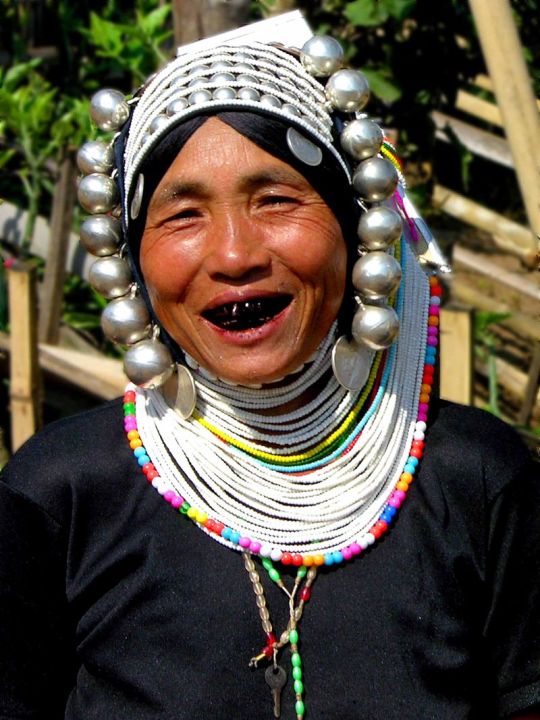
^Myanmar (Her teeth have been intentionally dyed black, a relatively common practice in parts of east and southeast Asia. The lacquer used prevents tooth decay.)
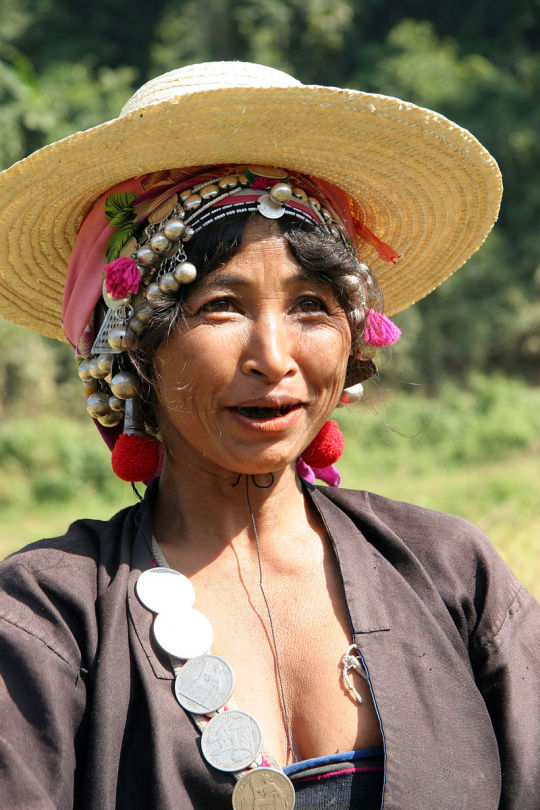
^Laos
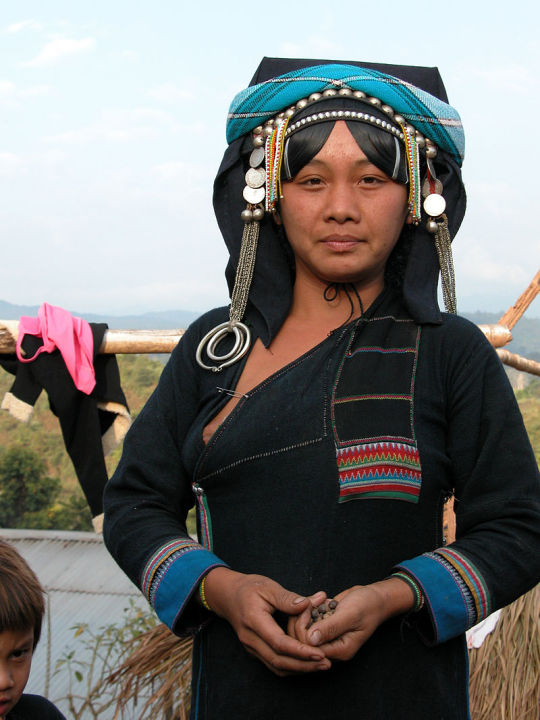
^Laos
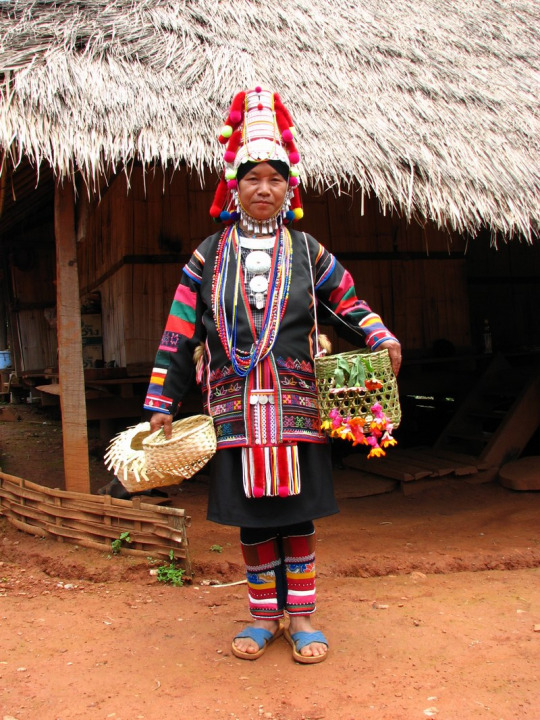
^Thailand

^Thailand
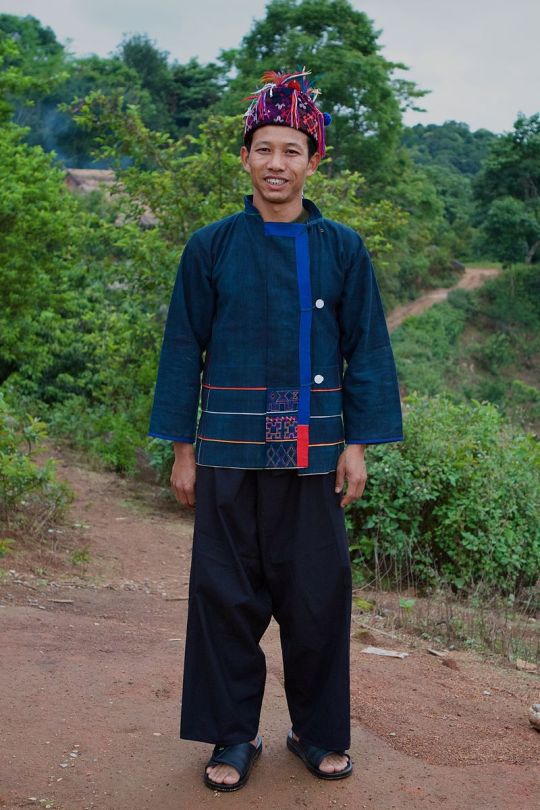
^ Ban Mae Chan Tai, Chiang Rai Province, Thailand
Akha society lacks a strict system of social class and is considered egalitarian. Respect is typically accorded with age and experience. Ties of patrilineal kinship and marriage alliance bind the Akha within and between communities. Village structures may vary widely from the strictly traditional to Westernized, depending on their proximity to modern towns. Like many of the hill tribes, the Akha build their villages at higher elevations in the mountains.
Akha dwellings are traditionally constructed of logs, bamboo, and thatch and are of two types: "low houses", built on the ground, and "high houses", built on stilts. The semi-nomadic Akha, at least those who have not been moved to permanent village sites, typically do not build their houses as permanent residences and will often move their villages. Some say that this gives the dwellings a deceptively fragile and flimsy appearance, although they are quite well-built as proved over generations.
Entrances to all Akha villages are fitted with a wooden gate adorned with elaborate carvings on both sides depicting imagery of men and women. It is known as a "spirit gate". It marks the division between the inside of the village, the domain of man and domesticated animals, and the outside, the realm of spirits and wildlife. The gates function to ward off evil spirits and to entice favorable ones. Carvings can be seen on the roofs of the villager's houses as a second measure to control the flow of spirits.
The traditional form of subsistence for the Akha people has been, and remains, agriculture. The Akha grow a variety of crops including soybeans and vegetables. Rice is the most significant crop and is prominent in much of Akha culture and ritual. Most Akha plant dry-land rice, which depends solely on rainfall for moisture, but in some villages irrigation has been built to water paddy fields. Historically, some Akha villages cultivated opium, but production diminished after the Thai government banned its cultivation.
The Akha have traditionally employed slash and burn agriculture, in which new fields are cleared by burning or cutting down forests and woodlands. In such a system, there is usually no market for land. Rights to land are considered traditional and established over many generations. This type of agriculture has contributed to the Akha's semi-nomadic status as villages move to clear new farmland with each successive burn cycle. The Thai government has forbidden this practice, citing its detrimental effects on the environment. The Akha have adapted to new types of subsistence farming, but the quality of their land has suffered as they are no longer allowed to expand onto new plots. In many cases, chemical fertilizers are the only option for re-fertilizing the land.
Akha religion — zahv — is often described as a mixture of animism and ancestor worship that emphasizes the Akha connection with the land and their place in the natural world and cycles. Although Akha beliefs and rituals involve all of these elements, the Akha often reject the casual categorization of their practices as such saying it simplifies and reduces its meaning. The Akha way emphasizes rituals in everyday life and stresses strong family ties. Akha ethnicity is closely tied to the Akha religion. It might be said that to be considered an Akha ethnically by other Akhas is to practice the Akha religion.
The Akha put a heavy emphasis on genealogy. An important tradition involves the recounting by Akha males of their patrilineal genealogy. During the most important ceremonies the list is recited in its entirety back over 50 generations to the first Akha, Sm Mi O. It is said that all Akha males should be able to do so. The recounting of this lineage plays a role in the incest taboo: If a male and female Akha find a common male ancestor within their last six generations, they are not allowed to marry.
Rights, issues, and activism
Being an ethnic minority with little easily accessible legal recourse, Akha everywhere have long been subject to rights abuses.
Perhaps the most important issue facing the Akha pertains to their land. The Akha relationship to land is vitally connected to the continuation of the Akha culture, but they rarely have "official" or state-sanctioned land rights or claims to their land as land rights are considered traditional. These conceptions of land are at odds with those held by the nation states whose land the Akha now occupy. Most Akha are not full-fledged citizens of the country they inhabit and are thus not allowed to legally purchase land, although most Akha villagers are too poor to even consider purchasing land.
It has been reported by rights groups that several land seizures of Akha land have been undertaken in the name of the Queen of Thailand. Originally a semi-nomadic people, the Akha are often relocated by the presiding national government to permanent villages, after which the government allegedly sells to logging companies and other private corporations access to lands formerly occupied by the Akha. The land onto which the Akha are displaced is almost always less fertile than their previous plots. On their new lands, the Akha can rarely produce enough food to sustain themselves and are often forced to leave and seek employment outside the villages, thus disrupting their traditional culture and economy.
In Thailand, laws have been passed that curb people's rights to the forest, including the 2007 Community Forest Act. According to the network of indigenous peoples in Thailand,
"These laws and resolutions have had severe impacts on indigenous peoples' rights to residence and land. Under these laws and resolutions millions of hectares of land have been declared as reserved and conservation forests, or protected areas. Today, 28.78% of Thailand is categorized as protected areas. As a result, thousands of farmers previously living in the forest or relying on the forest for their livelihood have been arrested and imprisoned and their lands seized. Cases have been filed against them for the so-called encroachment on government land."
Despite having signed and ratified the Convention on Biological Diversity, the Thai government has not changed laws to adhere to those recommendations emphasizing respect for the rights of indigenous peoples and their full and effective participation in protected areas management and policy-making.
The reasons given for Akha relocations vary, but a common response on the part of the Thai government is to cite a concern for the preservation of forests and the promotion of more sustainable agricultural techniques than the slash and burn agriculture traditionally used by the Akha.
Despite their numbers, the Akha are the poorest of all the hill tribes. As roads bring accessibility and tourists, they provide relief from the poverty of village life, especially for the younger generations who increasingly find themselves engaged in labor outside the villages. Many villages report a population decrease as many leave to find work in the cities, often for very long periods. Many Akha complain that the younger generations are becoming increasingly less interested in traditional culture and ways and more and more susceptible to outside, mainstream, cultural influences. According to one author, where the village squares were once "filled with the sounds of courtship songs", radios are now more likely to play pop hits.
As it becomes increasingly difficult to remain self-sufficient through agriculture, and as roads open up the villages to the cities, the Akha must contend with the sometimes corrosive effects of the tourist industry. Not all Akha are happy to let tourists come in and observe village life.
Many Akha complain of the missionaries that come to the villages to convert them, sometimes forcibly, to Christianity. Many Akha feel that the missionaries generalize about, or in this particular case, "paganize" the Akha traditional belief system, demeaning their longstanding beliefs. Some of the claims made against missionaries include the kidnapping of Akha children into orphanages and forced labor, the sterilization of Akha women and the forced or underpaid labor of Akha on farms. Many rights groups make the claim that the money spent by missionaries on building churches and furthering Christian education could be better spent on helping the Akha with medical and sanitation improvements that are greatly needed in most villages.
264 notes
·
View notes
Text
where to shop in hawaii
However slightly than go his normal route of Pan-Asian fusion, Yamaguchi brings one thing distinctive to the islands: Eating Home 1849 Named after one of many first eating places in Hawaii, lookpacific to island culinary heritage with dishes equivalent to quick rib beef luau” with candy potato gratin and waiahole poi and beef loco moco with fried rice and kalei egg - all sourced from local farmers, ranchers, and fishermen. Savor exotic Hawaiian flavors from locally-sourced island substances, in dishes together with Kalua Pig, Island Fish, Huli Huli Chicken, Sweet Potatoes and Hawaiian Fried Rice. where to eat in guam
With dishes like kalua pork , rooster lengthy rice , squid luau , poi , laulau , and lomi lomi salmon , an genuine Hawaiian meal will introduce you to the true tastes of the islands. The restaurant, named for Hawaiian surfer and Olympian Duke Kahanamoku, is on the lower degree of the Outrigger Waikiki Beach Resort Lunch prices are affordable, and you'll find deals any time of the day within the Barefoot Bar, where you can eat under a palapa, enjoy a seaside vibe and stare upon Diamond Head. So as an alternative of eating your everyday meals like hamburgers, fries and fried chicken, cease by a neighborhood restaurant or fish market and try out the lau lau and poke.
1 note
·
View note
Photo

Happy birthday to my love @toastedbuckwheat \^O^/ <333333333
Can’t believe another year has gone by already!! Wanted to do a seasons themed quadriptych but but decided to just pick 4 out of our many many AU’s with these two *3* (sorry to all babies in other universes, I will get around to drawing everyone sooner or later I promise sdfghjkl)
Hope this will be better year for bae and that we can finally escape away for a bit from everything. Love you so so much my dearest and I can’t be thankful enough for having you in my life every single day ;W; *BIG HUGS AND KISSES*
#Happy Birthday Adam!!!!!#I LOVE YOU BABEH ^3^#*TACKLES + ROLLS AROUND*#hope you're having a wonderful relaxing time rn- a solid relaxing break \O/#can't wait to squeeze ya in person u/////u#Adam's Birthday#birthday post#Maegthelion#Ec x Lomi#Lorien au#present day au#farmer au#minguo au#keeping ze tags simple cuz it's a mashup of ge x di x jie x mei aghfjkglghghjkl XDDDDDD#my art#mimimarilynart#Illustration#traditional art#Pen and Ink#markers#coloured pencils#lovers#love love love
9 notes
·
View notes
Text
Conculture notes on Gotevians/Gotêvi...
Kind of headcannon-y, cultural notes about Gotevians (and Gotêvi itself). Some are kind of generalizations (obviously not all people of X nationality are like Y), but still might help to give a general feeling to the people...
Reincluding this moodboard about Gotêvi:

~*~*~*~*~*~*~*~*~
Education is very important to Gotevians. Many believe it should be government-funded, but they are unlikely to have this wish fulfilled en masse. There is a limited amount of publically-funded education for children, but only in and around cities.
The sentiment is widely held that domestic and personal life shouldn’t be undermined by political or professional career.
The Gotevians take utmost care in making their homes as neat and aesthetically pleasing as possible.
Most tend to be quite formal when interacting with new acquaintances or strangers. If they are over 40, they probably use the title of respect meliarenwhen addressing peers in formal situations.
Despite how dearly they’d like to keep up the pretense, they really don’t care much for the Lomi on a social and cultural level, despite their historical and political alliance. They secretly think the Lomi are slightly unstable and backwards, though most Gotevians far too diplomatic and tactful to admit it.
Gotevians admire the ethereality of Bayën art and culture. They might view it as an escape from the mundane of their own society, or they might be drawn to the elusive and mysterious nature of the Bayë in general.
Despite its flourishing economy, Gotevians of the middle class make nearly all of their clothing and many grow a lot of their food, except for their exotic imports, such as various types of foreign spices, fruits, cloth, and precious gems and metals.
Gotvians love to wear linen, silk, and cotton. Often, to appear sophisticated, some might wear many thick layers of silk in the winter instead of wool. Wearing canvas or leather is considered pretty rugged, unless one is from the south of Gotêvi (which is a southern hemisphere place), where it gets really cold. This is where the Teg and Phul peoples dwell, who are culturally and ethnically distinct.
Most speak at least one other language apart from their their native regional Gotevian dialect. These may include Lomi, some language from Ei, the “standard” Gotevian dialect (though they don’t consider it as much another language as a different social register, or even something as exotic as Tosi (if you’re considerably cultured). If you do know Lomi, they generally only use it when they have to, and thus it’s a bit rusty for most people. More people speak Ori than speak Lomi. Gotevians like to trael to the Quariosian territories of Ei, and Ori is widely spoken there, even though Orikrindia is an independent state.
Cow’s milk is considered disgusting to drink. Goat cheese and milk, however, are standard foods in some places.
The mainstream ideal appearance for a man or woman is a slender, moderately tall of build, grey eyes and a pale face. Long hair and fingers are a plus as well. Overly muscled physiques generally don’t improve things.
Dancing is a favorite hobby, and most Gotevians consider themselves good at it and do it often.
The classically ideal number of children to have is 1-2, but most people are “unfortunate” enough to have more. But for royalty, this is desirable.
If your spouse dies, a Gotevian probably won’t remarry for quite a while, at least legally. If they separate from a spouse or partner, they often stay single for a long time afterward. Quickly remarrying is considered unwise and “looks bad”.
It used to be customary for males to undermine females in terms of royal succession, but this has been elimianted from law. On a day-to-day basis, gender roles in Gotêvi are fairly loose, compared with some other cultures in Aeniith.
By law, one can only have one spouse at a time.
May Gotevians have a slightly hard time understanding that there actually are people who believe in the concept of fate. As a culture, thy regard societies that believe in it at large to be bizarre and illogical. It viewed as primitive and dangerous.
The majority of Goetevians are not overtly religious. Some believe in some elemental spirits, but they do not worship them. Some people have some social ties to a local temple, priest(ess), or religious group, however, such institutions and persons are generally considered enigmatic and worthy of tacit suspicion.
One bathes every two days. Infrequent bathing is considered unpleasant, but over-frequent bathing is considered to be bad for the body. The environment’s too arid for that in any case.
Gotevian culture considers language arts to be the highest form of non-visual art, closely followed by drama and music.
It is popular to have a cat or ermine-type creature that lives in one’s house and which fed.
Those under approximately twenty-five who are member of the upper-middle-class, often depilate all the hair growing anywhere below below the eyelashes, regardless of gender. It’s considered to be a sign of cleanliness and consciousness, despite the fact that the older generations consider it to be silly and fastidious.
Regular nudity is proper only for the highest classes and possibly the lowest, depending on where one lives. Brief or practical nudity (such as occurs with changing clothes, public bathing, or working in hot weather) among the middle-class is acceptable, however.
Rape is a greater criminal offense than murder, and is punishable by 30 or more years in prison. Capital punishment was abolished under Gotevian rule in the year 403 E.K.
The kitchen is the largest room in the Gotevian house, unless one is wealthy, in which case, the main “all-purpose” nɛxivan room is.
Only children wear ankle-length socks. After the age of fifteen or so, thigh-length stockings with decorative garters are worn, except in the summer when most people wear long, light clothing to keep the sun off and to keep their legs cool.
Wearing shoes in a house that’s sufficiently heated is considered pointless and uncomfortable. It is polite to remove the shoes before entering a house, especially that of a host.
The only women who wear their hair up on their head are servants, manual workers, and queens.
All members of royalty and the higher nobility wear cosmetics in public, except small children.
It’s considered inappropriate for non-noble young people to wear heavy make-up in public places, unless there’s some kind of festival, ceremony, or something of the sort going on.
If someone becomes seriously ill, they can be fairly sure the local governmental services will pay for any advanced treatment, unless one is a proven criminal.
The majority of the populace is an artisan, farmer, or a working artist.
Many people have a large, soft, intricately designed rug on the floor in the main, non-kitchen room. It’s almost always an old family heirloom, and is never, ever walked upon with anything but meticulously clean or socked feet. If one has young children or infants, they commonly sleep on it.Sometimes adults sleep there as well during the middle of the day, when it is hottest, or at night by the hearth when it is cold.
When a person dies, their belongings, legally and traditionally, go to any surviving children, and are divided equally among them.
If one lives anywhere outside a large city, they have to prepare every summer for the possibility of wildfires.
Soft curls on either gender are considered very attractive, especially long, soft curls.
Those who live in one of the major port cities are often well-traveled and cultured, taking trips to Ei and even into Elta.
Staple foods include bread, vegetable or grain-based porridge-mash, or rice. Meat is reserved for special occasions. Many people grow vegetable gardens and herbs.
Young females between the ages of eleven or so to seventeen often keep bundles of lavender, mint, or rose petals in a chest of personal items to keep them from smelling stale.
Cane sugar is rare and expensive. Honey is usually used to sweeten food.
The idea of a strict patriarchy or matriarchy is disturbing to most Gotevians.
Many people of the lower and middle classes collect berries, nuts, roots, and edible flowers and leaves in the summer and autumn.
Gotevians tend to value serenity, sensitivity, and introspection.
Many people living outside large cities build their own house and live in the same dwelling all of their lives.
Most people don’t have a personal bathing room at home. If they live in a decent-sized town, there are public baths. Otherwise they use streams, lakes, or rivers.
The idea of theocracy is foreign and considered primitive by most Gotevians.
Most people wear silver more than gold, and not because it’s more abundant; it’s considered more appealing.
Most Gotevians count on living for about 90-100 years, yet they are deeply concerned about their mortal nature. It is not appropriate to discuss death or dying in polite situations, even euphemistically.
The typical Gotevian maintains a reserved, stoic, almost innocent public image, but are often more worldly and cunning than their appearance.
If one has the resources and money, most Gotevians conclude that there is no excuse for having an aesthetically unappealing living environment. Rich people who have no taste are considered pathetic and contemptible.
There are two meals taken per day: one in the late morning and one in the early evening. Gotevians drink lots of nourishing liquids through the day including herbal teas, fruit juices, and various elixirs that help keep up their health.
Symmetry is considered more aesthetically appealing than asymmetry. This is the biggest Gotevian gripe with Lomi art and fashion: it is seen as too chaotic and unbalanced.
#random#cultural notes#culture ideas#headcannons#aeniith#gotêvi#gotevians#worldbuilding#culture#world building#world-building#conculture#conworld#constructed culture#constructed world#world setting#fantasy#worlds
2 notes
·
View notes
Text
Words by Chris Kausman. Photos by Haute Culture.
The Akha are a large ethnic minority group dwelling predominantly in the hills of Northern Thailand. There are around 70,000 Akha people spread throughout Chiang Mai and Chiang Rai. This population is made up of three separate sub groups; the Lomi Ahka are the highest population, followed by the Ulo Akha and then the Phami Akha.
The Akha are originally from China and Tibet but they migrated to Burma, Lao and Siam (now Thailand) in the late 19th and early 20th centuries. In Yunnan province, China, where there are still considerable numbers, they are known as Hani people. They speak a ‘Loloish’ Yi language which is part of the Tibeto-Burman linguistic group and have no traditional written language.
How they live
Akha people predominately live in mountainous areas in small villages of around 30 families. Their houses are typically raised on low wooden stilts with walls constructed of bamboo and thatched roofs made from palm leaves. They are known to be excellent farmers, growing various crops of corn, rice and beans. They practice a slash and burn approach to agriculture which often damages forest eco systems and endangers native plant and animal species.
In the 1970s the Akha were prolific opium growers, traders and addicts. They reputedly suffered from the highest rate of addiction in comparison to their other hill tribe neighbours. This is probably due to the extreme poverty that affects most of the Akha. The problem resulted in much of the Akha’s land being revoked by the Thai army and the CIA clamping down on the group to put a stop to the opium trade.
Akha village in the hills of Chiang Rai, North Thailand. Photo Credit: Linda De Volder
Entrance to the Akha village North Thailand. Photo Credit: Linda De Volder
What They Believe
The Akha traditionally practice animism and ancestor worship, mixed with aspects of Buddhism. These traditions have slowly declined over time due to infiltration by missionaries and pressure to convert to Christianity. Those villages that have resisted change will carve wooden figures of a man and woman at the village gate to show the spirits that the village is the domain of humans. Socially, the Akha are egalitarian and status is afforded by both age and experience.
Their Traditional Dress
Each of the three sub groups wear a different headdress and use varying motifs and totems for their traditional dress. These incorporate sophisticated techniques of hand embroidery, reverse applique, couching and embellishments. All groups used to weave indigo dyed cotton on back strap looms to construct their clothing, but for some time now they favour a market bought polyester/cotton material.
Our textile teacher Aoh in her full handmade traditional Akha regalia
Aoh traditional dress from behind.
Aoh hand made al of her families traditional dress. The back of her jacket shows the extent of her intricate embroidery and applique skills. Modern developments include the use of plastic buttons instead of seeds or shells.
Amer is Aoh’s husband. All his traditional clothes have been handstitched by his wife.
The back of Amer’s jacket took Aoh over one year to hand embroider
A close up inspection of Amer’s jacket shows the beautiful Akha motifs stitched into the fabric.
Today Akha culture in Thailand is suffering greatly due to their assimilation into Thai society. Their traditional crafts are in danger of dying out and ceremonial customs are being lost as new generations strive to fit into the contemporary way of life seen in nearby cities. However, the Akha people are strong survivors and although many have remained relatively poor in the mountains, they still have a very strong and recognisable cultural presence overall, perhaps more so than any of the other tribal groups living in Northern Thailand.
Subsequent articles on Akha traditional dress and textiles and traditions will follow shortly.
About the Author
Chris Kausman is an Englishman who for the last 30 years he has been involved with tribal cultures from China and South East Asia, spending time with the people and purchasing costume, textiles and artefacts along the way. He has built up a close friendship with many different members of tribes and ethnic minorities and from this has accumulated much knowledge and understanding of these cultures and their artistic expression and skills. He is the founder of ‘RARE EARTH’ Tribal Art Gallery in Chiang Mai, Northern Thailand, which presents an eclectic, rare and museum quality collection of old and antique textiles, costume, silver adornments, ancient beads, and shamanistic paraphernalia.
Are you visiting Thailand? Pin this post and save it for later!
Akha Hill Tribe in Thailand
Textile Tribes of Thailand: An introduction to the Akha Ethnic Minority Words by Chris Kausman. Photos by Haute Culture. The Akha are a large ethnic minority group dwelling predominantly in the hills of Northern Thailand.
0 notes
Text
Eat local: Ocean-to-table dinner at Koko Head Cafe
We live in Hawaii, a cluster of islands surrounded by a vast ocean, so you’d assume all of our seafood is fresh and local.
Cold Smoked Aku Toast.
I was shocked when chef Lee Anne Wong told me that we import 60 percent of our seafood. SIXTY PERCENT. Pretty ridiculous, right?
Wong is on a mission to raise awareness of the issue through a collaboration dinner with Local I’a, the first community-supported fishery in Hawaii. The organization works with local fishermen instead of long line boats to supply sustainable, locally farmed and wild seafood to both restaurants and consumers. The Local I’a program includes traceability on where and when the seafood was caught, as well as insight and information on the person catching it. The program skips the middleman to profit the fisherman directly, helping to create and support local industry.
Although Local I’a supplies seafood to restaurants, retail customers like us can get their products at farmers markets on Oahu, Kokua Market Co-op, Waimanalo Co-op, their Community Supported Fishery (CSA) subscription service, and catering and pop-up events.
Poached Uku Ramen.
“As one of our seafood suppliers, we are collaborating with Local I’a on Tuesday, April 10 from from 6 to 8:30 p.m.,” Wong said. “The goal of this collaboration is to showcase Local I’a to the guests, and build awareness. The average consumer no longer has to rely on supermarket seafood and can get it fresh direct through Local I’a. Koko Head Cafe continues our mission to serve the freshest local ingredients with our creative island style menus.”
There will be a raffle for prizes, including wine and spirits, as well as shares to the Local I’a CSF. At least one or two of the supporting fishermen will be present to discuss the program and seafood guests will be eating.
The menu is as follows:
Cold Smoked Aku Toast, Lomi Tomato, Fried Sea Asparagus, Chipotle Aioli
Poached Uku Ramen, Truffle Shoyu Consomme, Alii Mushroom, Yuzu Kosho
Ono Confit, Bacon, Pineapple-Pepper Relish
Kauai Shrimp, Leek, Bouillabaisse, Rouille
Crispy Hebi Musubi, Lemongrass Shoyu, Green Onion Tartar Sauce
Basque Style Mahi, Ulu Cake, Mac Nut-Moringa Salsa Verde
Ama Ebi, Ume, Cucumber
Ahi, Sesame, Furikake, Popcorn
Ahi, Sesame, Furikake, Popcorn.
You can get tickets online, here. Johnson Brothers will be showcasing two cocktails, three wines and three Waikiki Brewing Co beers.
Local I’a and Koko Head Cafe collab dinner Tuesday, April 10, 6 to 8:30 p.m. $68 per person includes dinner and drinks, all inclusive of tax and gratuity Koko Head Cafe 1145C 12th Avenue
from WordPress https://ift.tt/2H0xFHB via IFTTT
0 notes
Text
Novotel Manila Araneta Center: My New Staycation Hideaway (Part 1)
I spent a good portion of my early teenage years living in the Cubao area. The first things I think about whenever I hear the words Cubao and Araneta would probably be busy bus stations, crowded MRT and LRT lines, the old Farmer’s Plaza and the gigantic Araneta Coliseum. But the Araneta Center itself has had a big facelift in the past decade with the opening of the Gateway Mall, major mall and retail renovations, and the construction of new high-rise condominiums. Still, I never fancied the Araneta Center as a place to go to for a relaxing staycation or a classy dining experience. All that changed once I stepped inside Novotel Manila Araneta Center, my new secret hideaway in Cubao.
Novotel Manila Araneta Center is a midscale hotel located inside one of the busiest and oldest commercial areas in Quezon City, the Araneta Center. But take one look at this business and leisure district now and you might not even recognize where you are. Some areas actually look more like Makati than Cubao. The Novotel brand is the more affordable and accessible name from AccorHotels, a world-leading travel & lifestyle group with over 4,000 hotels around the world operating popular brands such as Sofitel, Mercure, and my favorite Raffles and Fairmont hotels. Novotel Manila is the first Novotel hotel that opened in the Philippines, and I believe it is perfectly situated right in the heart of Quezon City.
It was my first time to check in at Novotel Manila for a much needed summer staycation. Parking was very easy using their multi-level covered parking facilities at the basement which directly connects to the lobby. The hotel’s contemporary design features 401 stylish rooms and suites with very affordable rates that are just right for traveling businessmen and quick family holidays. The lobby itself is bright and spacious, with a friendly atmosphere that immediately puts you at ease.
Novotel Manila’s interiors and designs are modern and playful, a relaxing change of scenery from the stressful urban jungles of Manila. Aside from the free wifi throughout the entire hotel, which is a welcome bonus for all hotel visitors, they also have Webcorner on a Mac, a set of desktop computers available for the use of guests 24 hours a day. Shopping and entertainment are also just a few steps away with the Gateway Mall and SMART Araneta Coliseum just adjacent to the hotel.
Being a member of Le Club AccorHotels, the chain’s loyalty rewards program, has its benefits which include special member’s rates, exclusive sales, online check-in, free nights, and priority check in at all Accor Hotels worldwide. Membership is absolutely FREE and easy to join (click here to register).
But since I was booked at their Executive Room, I had an even better privilege because it offered me private check in facilities at the Premier Lounge on the hotel’s penthouse floor. I just love it when I can do my check in while sitting down.
The Premier Lounge is a private and exclusive area on Novotel Manila’s topmost 24th floor where guests get to enjoy distinct bespoke services including personalized check in and check out, buffet breakfast, complimentary all-day refreshments, afternoon tea, evening cocktails, and use of the business center facilities while enjoying the panoramic view of Manila's skyline.
This special club lounge access is only available for hotel guests booked on the Executive Room and Executive Suite. I have been to several other club lounges at different hotels in Manila before, but I can honestly say that Novotel’s Premier Lounge has one of the best views and aesthetics. The high ceiling and almost 360-degree panoramic view from their floor-to-ceiling windows give the lounge a very spacious and charming ambiance.
Aside from being able to use the lounge from 6:00am to 11:00pm daily, guests can also partake from the various snacks and refreshments available as much as they want. The Chocolate Chip Cookies and Walnut Cookies are great to nibble on with any of their beverages including sodas, coffee, tea, juices, Sola Iced Tea and imported sparkling water.
They also have their Afternoon Tea from 3:00pm to 5:00pm daily which includes even more delightful desserts and savoury snacks to munch on like cakes, brownies and mini-sandwiches. I checked in just as their Afternoon Tea was starting so I took a few minutes to relax at the Premier Lounge and enjoy these added benefits.
The penthouse floor also has a Kids Play area just beside the Premier Lounge where children can read their favorite books and play gaming consoles while waiting for their parents to finish their coffee.
After my quick afternoon snack, it was time to stay at my Executive Room which was also located on the 24th floor. The room has 29 square meters of modern decor and ergonomic comfort, a colorful feast for the eyes. It also offers a great view of the busy city below, a cool and refreshing retreat from the sizzling summer heat.
My room comes with an LED flat screen TV, a small work area, safety deposit box, complimentary welcome fruits, and a personalized message from the hotel general manager that every guest always appreciates.
Coffee and tea making facilities plus a minibar are also included inside the room. Guests also have free access to the PressReader app on their mobiles which lets them download over 4,000 online publications from newspapers to international magazines. I’m ready to take my afternoon nap but I think I need a quick shower to freshen up first.
The bathroom also has a sleek contemporary design with its rain shower just beside the bed separated only by a clear glass window. I was looking for the blinds or curtain but I could not find any. I was wondering how non-couples will be able to take a shower in this room when I found a switch that suddenly turns the window into frosted glass! It was the first time I had seen such technology but I guess that solves that problem.
After my short nap, it was time to go around the hotel and check some of their other facilities. The Gourmet Bar by Novotel is a chic, informal lobby lounge on the ground floor serving savoury snacks, coffee and trendy drinks. This is a great place to unwind and meet friends and business associates who are just passing by the hotel.
The hotel also has its own modern fitness center on the sixth floor called In Balance by Novotel. This is where busy bodies can work out during their staycations to keep fit and healthy. Guests can also find the swimming pool and pool bar on this level so I think I will take a dip next morning.
Kids Club by Novotel is another fun children’s play area on the sixth floor which is actually open to the public. Checked in guests of the hotel are free to use the colorful facilities but outside guests can also enjoy these for a fee. Families with children no longer have to worry about bored kids because they can have fun here all day.
As the sun was beginning to set, I headed back to the Premier Lounge for their Evening Cocktails which happens daily from 5:00pm to 7:00pm. Here, you can enjoy unlimited servings of red and white wines, specialty cocktails, beers, and hors d'oeuvres to whet your appetites before going to dinner.
The balcony of the Premier Lounge is the perfect setting to watch the sunset with a glass of Chardonnay on hand. It has been a magical day but the night is still young because it’s time to have my dinner buffet downstairs at Food Exchange.
Food Exchange Manila is Novotel’s all-day dining restaurant serving an international selection of sumptuous buffet items. I already blogged about Food Exchange Manila during their Go Gangnan! Korean Food Festival so I knew that it was going to be a bountiful dinner buffet.
This summer, Food Exchange Manila lets its diners indulge in limitless seasonal skewers from their Chefs’ grilling station. From March 17 - May 31, Grills N Skewers offers a selection of succulent meats, fresh seafood and organic vegetables all freshly grilled. I got some crabs, squid, and beef barbecue for myself.
I have my own favorite areas at Food Exchange Manila including the seafood station where I can get crabs, mussels, and prawns then have them cooked in glorious butter garlic. The carving station is always a popular destination especially with its Roasted Pork Belly-Chon, but I always drop by the Chinese station where I can customize my own plate of Stir-Fried Beef cooked hot off the wok.
Check out this rainbow-colored chocolate fountain at the dessert station! Novotel Manila also lets 2017 graduates eat for FREE at Food Exchange Manila as long as they dine with at least one full paying adult. Graduates only need to present their diploma, graduation photo, or graduation program with the graduate’s name along with their school ID to avail the promo from March 1 to July 31, 2017.
After that satisfying dinner buffet, there was one last activity I had scheduled for the day, a relaxing massage at In Balance Spa on the fifth floor. Described as an oasis right inside the bustling city, In Balance Spa boasts of stress-reducing services delivered by some of the most experienced massage therapists in the metro.
I arrived a few minutes before my 10:00pm massage service and was led to their comfortable waiting area to fill up a short registration form. Hot tea and a warm face towel was offered to start my heavenly journey.
You can choose the couple’s room for those who want a private and romantic massage session. The In Balance Signature Massage offers a fusion of techniques with Thai stretching and Hawaiian Lomi Lomi strokes. I decided to get the Swedish Massage which offers more gentle strokes for the ultimate relaxation experience.
For couples celebrating a special occasion, they can also spend some time inside the Jacuzzi which is also part of their Spa services menu. Besides the range of massage services, also featured are the Signature Body Scrubs using salt and aloe vera as well as one that makes use of organic red rice from the highlands of Mindoro.
I had such a wonderful hour at In Balance Spa and I felt so relaxed and de-stressed. I got back to my room and had one of my most enjoyable slumbers, especially with their ultra-soft mattresses. But this is just half of my Novotel staycation experience because I have yet to explore their swimming pool and enchanting Bridal Garden which magically transports its guests to another kingdom. Their new ice cream parlor - Ice N Cream by Novotel is also a fantastic venue to beat the summer heat. You might even get the chance to win an overnight stay in an Executive Suite with Premier Lounge access plus one year’s supply of ice cream! So check out Part 2 of my Novotel staycation.
Novotel Manila Araneta Center
Gen. Aguinaldo Avenue, Araneta Center, Cubao, Quezon City
990-7888
www.novotel.com/Manila
www.facebook.com/NovotelManilaAranetaCenter
0 notes